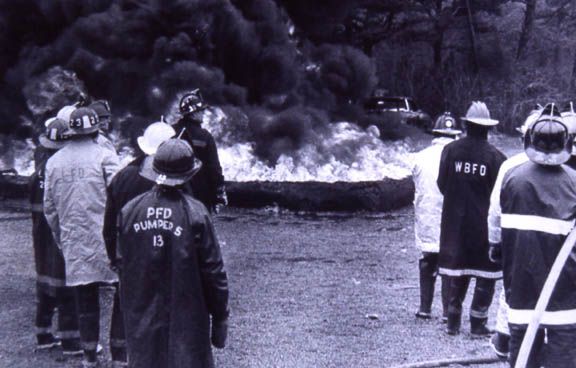
PFAS Mitigation
Overview
The Former Municipal Fire Training Site was contaminated with chemicals referred to as PFAS, which is a collective term for a class of compounds – poly and perfluoralkyl substances. The PFAS are believed to be from the fire training at the Former Municipal Fire Training Site from the 1970s to 2009 with foams specifically formulated to fight certain types of fires. Unknown to all, PFAS in the foams were contaminating the soil at the Former Municipal Fire Training Site, the groundwater beneath and downgradient of the facility, and Flintrock Pond directly to the west of the Former Municipal Fire Training Site. The PFAS release is regulated by the Massachusetts Department of Environmental Protection (MassDEP) under the Massachusetts Contingency Plan, the environmental regulations that govern the assessment and cleanup of uncontrolled releases of oil or hazardous materials.
The PFAS Release and the Former Municipal Fire Training Site were assigned Release Tracking Number (RTN) 4-0026179 by MassDEP in 2016. All documents about the Former Municipal Fire Training Site submitted to MassDEP are available on the MassDEP Searchable Sites Database. They are listed in the database by RTN 4-0026179. The most important documents are also available on this webpage. The documents describe the extensive explorations and testing that have been done at the Site and the remediation and mitigation of the PFAS that have been done so far. The work is not limited to the Former Municipal Fire Training Site. The regulations require that the contamination has to be followed wherever it may have migrated to.
There are numerous phases of work to assess and clean up the PFAS contamination under the MassDEP regulations. The Phase I Initial Site Investigation (ISI) was completed in 2018. Major mitigation work has been and continues to be conducted as Immediate Response Actions. That works includes pumping out contaminated groundwater and treating it, removal of highly contaminated soil from the Former Municipal Fire Training Academy Site, interim capping of the entire facility after the demolition of the fire training structures and testing groundwater across a wide area.
The Phase II Comprehensive Site Assessment (CSA) is the next major phase of the MCP process to mitigate the PFAS contamination. It is underway at this time. The Phase II CSA will assess how far and where the PFAS contamination has traveled with the groundwater and how it has impacted the adjacent pond and other small ponds in the immediate area. Most importantly, Phase II will evaluate the potential risks to human health and the environment from the Former Municipal Fire Training Site-related PFAS at the site.
All of the information derived from the current study will be used to evaluate and select final, comprehensive remedial actions for all aspects of the PFAS contamination during the next phase of the mitigation and cleanup process.
History
In 1956, County Fire Chiefs, through Barnstable County, began operating the Barnstable Fire Training Academy on the 6.2-acre property owned by the Cobb Family Trust.
The Academy provided a critical and necessary life-saving training facility for all the Cape’s firefighters, offering programs, education, and essential training that the Towns could not otherwise afford.
From its inception, the oversight of the operations fell principally to the Hyannis Fire Department until 1986, when it was turned over to the County. The County acquired the title to the real estate in 1983 through a deed from the Cobb Family Trust. The conveyance included the land and Flint Rock Pond, approximately 1.5 Acres, as part of the whole 6.2-acre site.

Use of Foam
Foam was used in firefighting training across the Cape dating back to the 1950s. The foam used at the Hyannis Airport and the Fire Training Academy until the approximately mid-1970s was a non-toxic protein foam. In the 1960s companies including the 3M Company and Dupont had begun to develop new types of fire-fighting foams that contained complex carbon chains with fluorine compounds attached – PFAS. These chemicals were resistant to heat and degradation, aided the production of a robust foam, and were more effective fire suppressants.
In the 70s closed aqueous fire-fighting foams were fast becoming used by firefighters across the country as a standard operating procedure. Training with these foams was required by the FAA at major airports. Unfortunately, these chemicals were found to not break down in the environment, were resistant to chemical and bio-degradation, may bio-accumulate in the environment, and are linked to serious health effects.
The County never purchased foam and so there are no records of when it came into training use at the Academy. When foam was used for training it was at the discretion of the local fire chiefs or other organizations using the former Academy and the foam would be supplied from off-premise.
Following the Silent Spring Report in 2009, the County moved to forbid the use of foam at the site and no PFAS foams were used at the Academy after 2009.
Silent Spring
The Silent Spring Report in 2009 took a critical look at Hyannis water. It concluded that the intrusion into the regional groundwater of PFOS and PFOA was attributable to multiple sources, including the discharge at the WWTP, (treatment at the discharge points for PFOS/ PFOA is not presently mandated), septic releases, a multiple of both industrial and household releases generated from materials that contained Teflon products and scotch guard treated materials (carpets, rugs, clothing). AFFF was used routinely at the airport and the academy, and this report caused the County to ban the use of foam. For the first time, the information also began to draw the debate on environmental corrective measures because the byproduct of these products was shown to travel in air and water as it bioaccumulated in the system.
In 2016, former County employee and Licensed Site professional Tom Cambareri tested the faucets at the academy and found that the water that the County was using from the Town hydrants in the Town’s main distribution system contained PFOS / PFOA, further compounding a pre-existing challenge. Therefore, even though the County was utilizing a pump and treat system to remove the contaminant, it was collecting in earnest by attaching to soils and water on the grounds as they spayed. The Town’s prompt response to add the carbon filters and monitoring by Suez has arrested that threat, and tests are now negative, and they will continue to be so as we work in partnership with the Town.
The Mary Dunn Wells
The Mary Dunn Wells were developed downgradient of the Barnstable WWTP, Hyannis Airport, Hyannis commercial establishments, and the BFTA by the Barnstable Water Company in 1975-76 as a seasonal supplement. In 2003 Mass DEP published a Source Water Assessment and Protection Report (SWAP) for the Barnstable Water Company. They identified scores of potential sources of contamination, including the Airport, FTA, WWTP, 30 fuel-dependent business and repair shops, 75 septic systems, 16 oil and hazardous material sites, and much more.
Recommendations for mitigation and monitoring were delivered, and many were phased in after Barnstable purchased the water company in 2006. Indicative of what was stated regarding hydrology, and as predicted in the SWAP, in 2006, a perchlorate release from Cape Cod Potato Chips flowed east downgradient through the FTA and onto the MDW. Tom Cambareri immediately re-engaged a pump and treated system installed before the release at the Academy to clean the site from Methyl tert-Butyl ether (MTBE) and other oil accumulations. He added monitoring stations to deal with this latest off-site intrusion. That pump and treat system has been upgraded and used today at the FTA.




